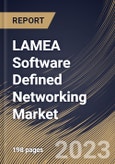A software defined networking (SDN) technology facilitates centralized, intelligence-driven network control by establishing a global perspective. It has revolutionized the networking architecture by enabling the flexible administration and control of complex networks via data traffic management and resource optimization. In order to provide a programmable network platform, software defined networking separates the control plane, which controls and routes network traffic, from the data plane, which merely transmits the traffic to its intended destination. Software defined networking provides communication service providers with enhanced agility and robustness, congestion relief, cost and time efficiency, infrastructure flexibility, and rapid innovation.
The development of the market is fuelled by key factors like a surge in the adoption of cloud computing, an increase in investments in software defined networking function virtualization, especially to minimize the capital expenditure & operating expenses, and a rise in the need for various mobility services. The surge in the acceptance of cloud computing solutions in the SDN network plays a crucial role in improving the overall operability, security, and network manageability in advanced data centers.
LAMEA organizations focus on data center modernization, and SDN plays a crucial role in optimizing data center networks. Countries in the Middle East, such as the United Arab Emirates, have been particularly active in fostering technological innovation and digital transformation. According to the International Trade Administration, Brazil is the most extensive economy in Latin America and continues to experience rapid e-commerce growth of 14.3% in 20232, which should exceed US$200 billion by 2026. SDN facilitates efficient data flow and analysis, allowing businesses in Brazil to gather valuable information for personalized marketing strategies and improved customer experiences. As a result, these aspects will boost the market growth in the coming years.
The Brazil market dominated the LAMEA Software Defined Networking Market by Country in 2022 and would continue to be a dominant market till 2030; thereby, achieving a market value of $1,387.5 million by 2030. The Argentina market is showcasing a CAGR of 20.5% during (2023 - 2030). Additionally, The UAE market would register a CAGR of 19.5% during (2023 - 2030).
Based on Offering, the market is segmented into Software, SDN Infrastructure and Services. Based on Type, the market is segmented into Open SDN, SDN via Overlay, SDN via API, and Hybrid SDN. Based on Application, the market is segmented into SD-WAN, SD-LAN, Security Applications, and Others. Based on End-User, the market is segmented into Enterprises, Telecommunication Service Providers, and Cloud Service Providers. Based on Vertical, the market is segmented into BFSI, Government & Defense, Education, Healthcare & Lifesciences, Media & Entertainment, Manufacturing, Retail & eCommerce, ITeS and Others. Based on countries, the market is segmented into Brazil, Argentina, UAE, Saudi Arabia, South Africa, Nigeria, and Rest of LAMEA.
The market research report covers the analysis of key stake holders of the market. Key companies profiled in the report include Cisco Systems Inc., Huawei Technologies Co., Ltd. (Huawei investment & Holding Co., Ltd.), VMware, Inc. (Broadcom Inc.), Dell Technologies, Inc. (Dell EMC), Juniper Networks, Inc., IBM Corporation, Ericsson AB, Ciena Corporation, Hewlett Packard enterprise Company and Nokia Corporation.
Scope of the Study
Market Segments Covered in the Report:
By Offering
- Software
- SDN Infrastructure
- Services
By Type
- Open SDN
- SDN via Overlay
- SDN via API
- Hybrid SDN
By Application
- SD-WAN
- SD-LAN
- Security Applications
- Others
By End-user
- Enterprises
- Telecommunication Service Providers
- Cloud Service Providers
By Vertical
- BFSI
- Government & Defense
- Education
- Healthcare & Lifesciences
- Media & Entertainment
- Manufacturing
- Retail & eCommerce
- ITeS
- Others
By Country
- Brazil
- Argentina
- UAE
- Saudi Arabia
- South Africa
- Nigeria
- Rest of LAMEA
Key Market Players
List of Companies Profiled in the Report:
- Cisco Systems Inc.
- Huawei Technologies Co., Ltd. (Huawei investment & Holding Co., Ltd.)
- VMware, Inc. (Broadcom Inc.)
- Dell Technologies, Inc. (Dell EMC)
- Juniper Networks, Inc.
- IBM Corporation
- Ericsson AB
- Ciena Corporation
- Hewlett Packard enterprise Company
- Nokia Corporation
Unique Offerings
- Exhaustive coverage
- The highest number of Market tables and figures
- Subscription-based model available
- Guaranteed best price
- Assured post sales research support with 10% customization free
Table of Contents
Companies Mentioned
- Cisco Systems Inc.
- Huawei Technologies Co., Ltd. (Huawei investment & Holding Co., Ltd.)
- VMware, Inc. (Broadcom Inc.)
- Dell Technologies, Inc. (Dell EMC)
- Juniper Networks, Inc.
- IBM Corporation
- Ericsson AB
- Ciena Corporation
- Hewlett Packard enterprise Company
- Nokia Corporation
Methodology

LOADING...








